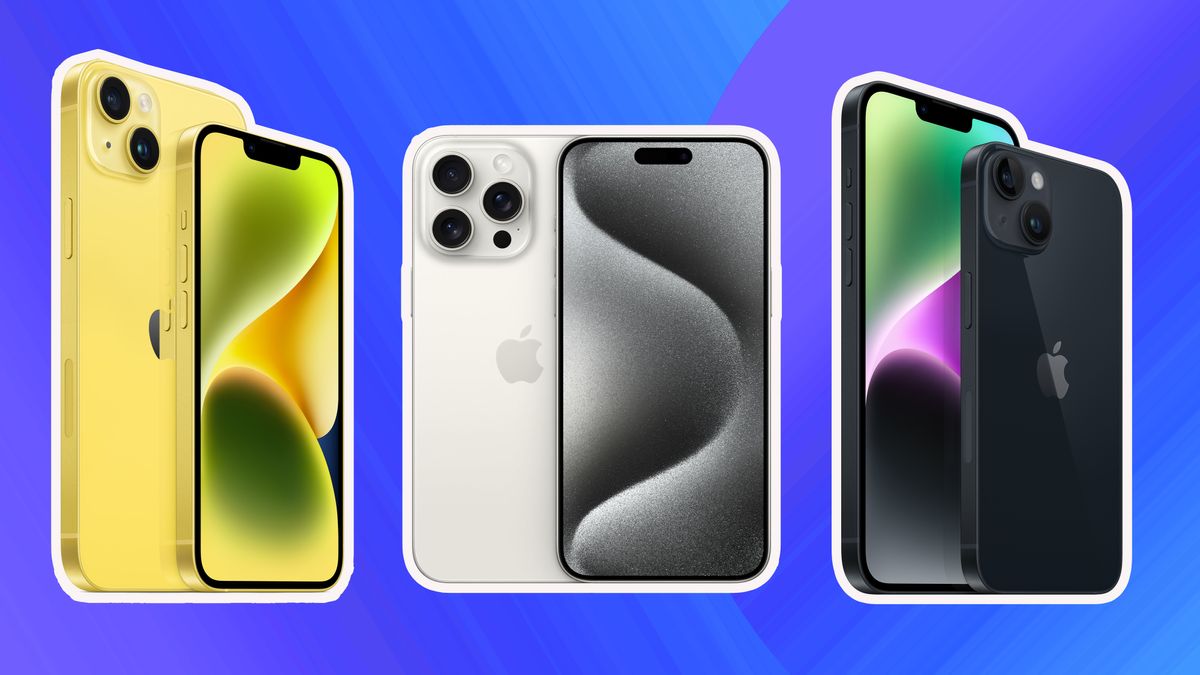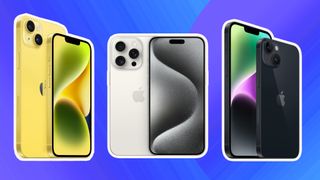
Jump to the quick list↴
1. Best overall: iPhone 15 Pro Max
2. Best value: iPhone 13 Pro
3. Best reliable: iPhone 14 Pro Max
4. Affordable: iPhone SE 2022
5. Best veteran: iPhone 12 Pro Max
6. Another budget: iPhone 12 Pro
7. Best mini: iPhone 12 Mini
How to choose
How we test
FAQs
Some of the best camera phones on the market right now are powerful enough to rival even professional mirrorless or DSLR cameras. However, finding the best iPhone for photography isn’t quite as simple as just choosing the newest or most expensive one in the product range (like the iPhone 15 Pro Max).
We know that every year Apple will upgrade its iPhone camera features, no matter how minor, but despite the temptation of owning a shiny new toy, it’s no good spending your hard-earned money on the latest flagship iPhone if it’s not necessary – and other budget camera phone options exist too.
Apple’s track record with photography has been pretty consistent, with minimal differences between iPhone generations. This offers plenty of choice if you’re not fussed about owning the newest iPhone. As a photographer, I have no interest in the iPhone 15 Pro Max and would choose the Samsung Galaxy S24 Ultra instead every time. But that’s just my personal preference. Whether you’re a pro smartphone shooter or enthusiastic to learn, you’ll want to opt for the best phone to suit your lifestyle, budget, and daily photography habits.
Quick List

The iPhone 15 Pro Max is Apple’s latest and most expensive product in the iPhone family, which by default makes it the best iPhone for photography given the upgraded camera features putting it ahead of last year’s model. It has a 120mm telephoto lens, and 25% larger quad-pixel sensor for quality images.
Read more below
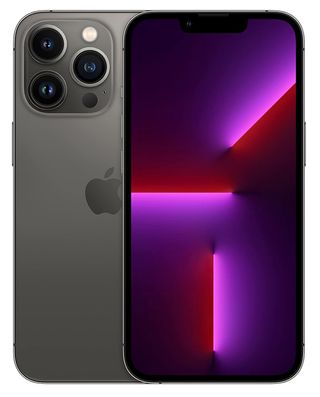
Now two years old, the iPhone 13 Pro is excellent value and considerably cheaper than its shiny new siblings. It has an identical camera to the iPhone 13 Pro Max model too, so as long as you’re not fussed about a bigger display this iPhone is a winner for photographers on a tighter budget.
Read more below
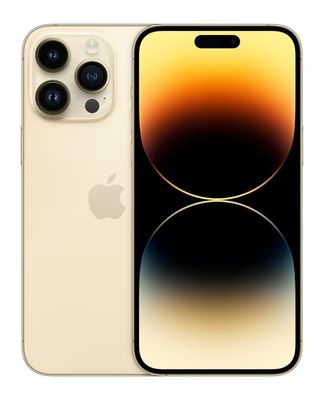
There’s absolutely nothing wrong with still owning last year’s iPhone 14 Pro Max model, which is why we’re calling it the most reliable iPhone for photography. There have been reports of the iPhone 15 Pro overheating, so you might want to stick with the 14 series to be on the safe side of technical faults.
Read more below
The best iPhone for photography
Why you can trust Creative Bloq
Our expert reviewers spend hours testing and comparing products and services so you can choose the best for you. Find out more about how we test.
The best iPhone for photography overall
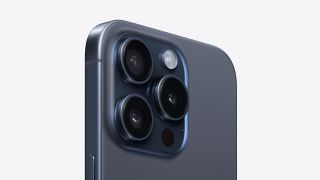
01. Apple iPhone 15 Pro Max
Specifications
Reasons to buy
Reasons to avoid
At the top of our list, we have Apple’s iPhone 15 Pro Max, which might be contradictory to everything we’ve already said about the newest iPhone not necessarily being “the best”. But while we still stand by this statement, if we’re boiling it down to the specs on paper, the iPhone 15 Pro Max is technically the best iPhone for photography given the (however minor) camera modifications and updates compared with last year’s iPhone 14 Pro Max model.
It has the exact same main camera as the previous model, but with an upgraded sensor that still uses Pixel-binning (so really it only outputs at 24MP, not 48MP) and an upgraded 120mm telephoto lens which now offers 5x optical zoom instead of 3x optical zoom, but this uses periscope-like methods of bending light to achieve the zoomed-in image, so quality is not guaranteed here.
There’s also the option to customise the default lens, and the phone can now shoot 48MP HEIF as well as Apple Raw. The iPhone 15 Pro Max has also been updated with higher resolution in more focal length options including 24mm, 28mm, and 35mm. With all of this said, the iPhone 15 Pro Max is the best iPhone for photographers who are striving for image quality and post-processing features above all else, although its thin lines between this model and the iPhone 14 Pro Max, so if you want to save some money, last year’s iPhone might be the one to go for instead.
• Need a case? See our picks of the best iPhone 15 Pro Max cases.
The best value iPhone for photography
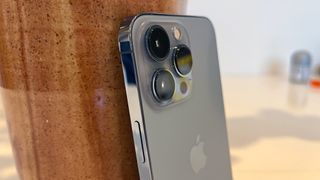

Specifications
Reasons to buy
Reasons to avoid
The iPhone 13 Pro is now more affordable than ever given the recent iPhone 15 series launch. It has a 12MP main sensor which is a step down from the 48MP sensor in the new iPhone 15 Pro Max and even the iPhone 14 Pro Max. But it’s still pretty great for photography and is now considered great value too (if you can get hold of one, that is).
The 13 Pro was a big step up from the iPhone 12 Pro and Pro Max (featured in this guide) in terms of camera specs, and they already had pretty astounding camera arrays. Physically, its sensors are similar to those of the previous generation: a three-lens array with a wide, super-wide and telephoto option. But the difference comes in their performance, with improved maximum apertures and increased optical zoom.
When we reviewed the iPhone 13 Pro, we found general image quality to be much improved across the board. And we’re not talking about subtle differences that only a trained eye would notice. We compared shots from an iPhone 13 next to shots from an iPhone 12, and the difference was clear immediately – the colours pop more, there’s more detail and better contrast. The in-built stabilisation is pretty amazing too, meaning you don’t need a gimbal. See our iPhone 13 Pro camera tips to get the most out of this iPhone.
The best reliable iPhone for photography
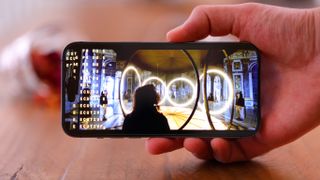

Specifications
Reasons to buy
Reasons to avoid
The iPhone 14 Pro Max was launched in September 2022, along with the iPhone 14, the iPhone 14 Plus, and the iPhone 14 Pro. It’s our pick as the most reliable iPhone for photography, given that the latest iPhone 15 series has faced its fair share of scrutiny with reports of overheating, mediocre upgrades, and expensive price.
The iPhone 14 Pro Max shares the exact same 48MP main sensor camera as the iPhone 15 Pro Max, yet offers a huge leap from the previous 12MP sensor found in the iPhone 13 series. That means full-resolution, 48MP RAW files are packed with detail with this phone, and its generous sensor size allows for more light to be flooded into your lens, particularly handy when shooting at night or in low-light conditions. The camera also boasts a wider-than-usual, 24mm angle of view and an f/1.78 aperture lens with OIS.
The iPhone 14 Pro Max also boasts an ultra-wide 12MP sensor with a 13mm expansive angle of view, and an f/2.2 aperture. The 12MP telephoto sensor offers roughly a three-times zoom equivalent, with a 77mm angle of view, image stabilization, and an f/2.8 aperture. To learn more about this phone, read our full iPhone 14 Pro Max review.
On the downside, the iPhone 14 Pro Max (despite being replaced by the iPhone 15 series) is still quite expensive, which is why we recommend the iPhone 13 Pro model over this one if your budget is a bit stricter. You may even prefer some of the other iPhone models further down this list, which should cost even less now they’re a bit older. We also advise shopping for refurbished Apple tech if you want newer models at a fraction of the cost, and this is a great way to promote recycling and the recommerce industry at the same time.
The best affordable iPhone for photography
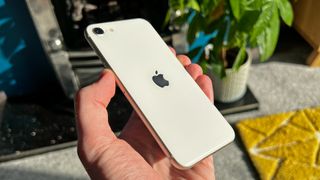
Specifications
Reasons to buy
Reasons to avoid
Apple’s iPhones have long been characterised as premium and, some would say, overpriced. Apple sought to combat this perception with the budget iPhone SE in 2020, and that was great news for anyone looking for an affordable iPhone for photography. The new 2022 SEbmodel however sports the same lens as the 2020 original: a 12MP rear camera with an f/1.8 wide-angle lens, plus a 7MP front camera with an f/2.2 wide-angle lens.
There’s only one lens on the back of the phone (wide angle, with no ultra wide or telephoto lenses), so it can’t compete as well with some of the best iPhones for photography listed above. But if all you need is a rock-solid point-and-shoot iPhone to document your day at the cheapest price, then the iPhone SE does hold its own.
The upgrade offered by the 2022 iPhone SE camera when compared to the 2020 model is the A15 chip, which delivers improved processing power. There’s no Night Mode, Dolby Vision HDR, or Cinematic Mode for video with this device – but you do get vitals like Portrait Mode here.
When we reviewed the iPhone SE (2022), we tested its camera against the top-end iPhone 13 Pro, and found that photos when compared side by side had less vibrant colours and a less expansive dynamic range, although the level of detail was actually on par. The iPhone SE lightens its shadows more than the iPhone 13 Pro, something that some users may actually prefer if they don’t intend on doing any editing.
The best veteran iPhone for photography
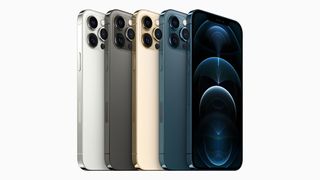

05. iPhone 12 Pro Max
Our expert review:
Specifications
Reasons to buy
Reasons to avoid
Moving further down the generations we have the iPhone 12 series, released in 2020, when the iPhone 12 Pro Max was the king of iPhone cameras for quite some time and still represents a sound investment now.
Apple squeezed all of its best camera tech into its largest and most expensive phone at the time, and unlike the iPhone 13 Pro Max, which sports the same camera as the smaller 13 Pro, there are a lot of differences between the iPhone 12 Pro Max and iPhone 12 Pro (below) cameras for photographers to decide between.
For starters, the ultra-wide lens on the iPhone 12 Pro and Pro Max are the same, but the 12 Pro Max model has a better wide and telephoto camera than the 12 Pro model. The Max has a wide lens with a sensor that’s 47% larger than the Pro model’s, making night mode functions much quicker and more powerful.
The Pro Max model also has a longer telephoto lens (2.5x vs only 2x on the Pro) with better optical zoom (5x vs 4x on the Pro) and digital zoom (up to 12x rather than 10x with the iPhone 12 Pro). There’s also Apple’s sensor-shift optical image stabilisation, which stabilises the sensor itself rather than the lens to improve your photo quality.
So we think there’s a clear winner when deciding between the iPhone 12 Pro vs Max in terms of photography, although, you might not notice a big enough difference in image quality here to really justify an upgrade or spend any extra money. The choice lies in your budget and how much you care about shooting long-range.
The best mediocre iPhone for photography
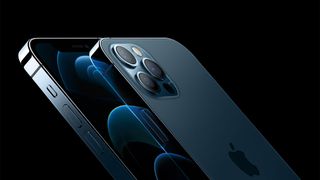
Specifications
Reasons to buy
Reasons to avoid
We’ve already discussed some of the key differences between the iPhone 12 Pro and its slightly more impressive 12 Pro Max sibling above. But, you definitely shouldn’t rule out this iPhone for photography if you prefer using a smaller and more compact device, and if you’re looking to save yourself some money in the process.
The 6.1-inch display on the iPhone 12 Pro is plenty enough for most people, and a larger display, while nice for viewing your photos, can add unnecessary weight. Its zoom range is a little lower than the Pro Max, at 4x digital zoom against 5x, and the lens apertures vary slightly. But other than that, you get a brilliant photography setup, including night-mode portraits enhanced by the device’s LiDAR scanner.
You might have to compromise a little on battery life with the iPhone 12 Pro, but if you still want a superb iPhone camera while saving some money, the iPhone 12 Pro is a good one to go for, and only marginally different from the iPhone 12 Pro Max in terms of features and functionality.
See our full iPhone 12 Pro review for more details.
The best mini iPhone for photography
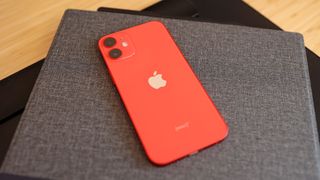
Specifications
Reasons to buy
Reasons to avoid
We can’t leave out the iPhone 12 mini. This sibling to the iPhone 12 devices above is an equally capable camera phone for photography and, again, a great option for those looking to save money. Don’t discredit this mighty mini too soon, as it offers two rear cameras, an ultra-wide f/2.4, and a wide f/1.6 with 5x digital zoom.
Is size an issue for you? If you want a smaller iPhone that’s portable and easier to shoot with, then the 5.4-inch iPhone 12 mini is an excellent choice. It sports the same cameras as the standard iPhone 12 but in a handy, more palm-friendly format. That makes it the most portable option out of all of the entries in this article – especially the Pro Max variants, and also much more affordable.
In short, whether you want a smaller iPhone for photography or are just looking to save some cash, it’s a great option (of course, for a little more cash, you might also consider the iPhone 13 mini). See our full iPhone 12 mini review for more details.
How to choose
When choosing the best iPhone for photography, it’s easy to go in order starting with the latest release. And yes, while the newest iPhone is usually the best one for photography technically, with improved specs and features compared with last year’s iPhone, that doesn’t necessarily mean that it’s the one you should choose or the best iPhone for your lifestyle or budget.
We suggest that you start by figuring out how much you want to spend first, and then look at the desirable features which make that particular iPhone a great asset for photography. Remember, it’s not always about megapixels. If you shoot a lot of video then you’ll want an iPhone with 4K capability (iPhone 12 or above is best).
If you know that you’d prefer an iPhone with USB-C charging, then that narrows your options exclusively to the iPhone 15 series, the standard, iPhone 15 Pro, or iPhone 15 Pro Max models to be exact.
How we test
At Creative Bloq, we enjoy putting phones through their paces when it comes to testing, with benchmarks in place to measure battery life, response rate, general use – and the camera, of course. Although manufacturers carry out their own testing on phones, we think it’s important to have an unbiased reviewer on the case to detect any flaws or find genuine reasons why we think a device might not be the best fit for creatives.
With so many phones out there, it can be hard to know which ones are really the best value for money. So with this in mind, we spend significant time testing phones to see how they perform in the real world. We do this by using social media and checking the upload speeds, running photo editing software, streaming video content, and testing the camera in different real-world scenarios.
It can be easy to geek out over the latest top-spec phones, which is why we also take pricing into account when pitting similar phones against each other, and seriously consider if a device is worth the hard-earned income of our readers. If we find that a phone isn’t all that up to scratch, we’ll be honest and recommend alternatives where possible. For more information, see our guide to how we test and review at Creative Bloq.
FAQs
Is there a big difference between the iPhone 14 Pro Max and 15 Pro Max?
Honestly, there isn’t a big enough difference in camera quality between the iPhone 15 series and iPhone 14 series for many people to justify making the upgrade. It was confirmed that the iPhone 15 Pro and Pro Max devices had the exact same 48MP main camera as the iPhone 14 Pro and Pro Max models, but with a few minor upgrades including three-axis stabilisation and a 25% larger quad-pixel sensor.
The iPhone 15 camera also offers higher resolution in more focal lengths than the iPhone 14, and it can shoot in the 48MP HEIF format as well as Apple Raw for enhanced quality and flexibility with editing.
What are the best iPhone alternatives?
If you’re serious about smartphone photography, know that there are plenty of excellent camera phones out there that aren’t made by Apple. For example, the Google Pixel 8 Pro was the first camera phone to make use of generative AI, and there’s also the newly released Samsung Galaxy S24 Ultra too which is being praised for its low-light capabilities.
We also highly recommend the Xiaomi 14 and Xiaomi 13 Pro smartphones since their camera units blew us away when we reviewed them. Huawei also makes exceptional camera phones, like the Huawei P40 Pro, one of the most innovative camera systems on the market.
We can’t leave out Oppo either, which makes use of Hasselblad lenses in its camera units for great image quality. The latest Oppo Find X7 Ultra smartphone is equipped with the world’s-first HyperTone camera system.
